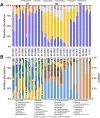Initial acquisition and succession of the cystic fibrosis lung microbiome is associated with disease progression in infants and preschool children
- PMID: 29346420
- PMCID: PMC5773228
- DOI: 10.1371/journal.ppat.1006798
Initial acquisition and succession of the cystic fibrosis lung microbiome is associated with disease progression in infants and preschool children
Abstract
The cystic fibrosis (CF) lung microbiome has been studied in children and adults; however, little is known about its relationship to early disease progression. To better understand the relationship between the lung microbiome and early respiratory disease, we characterized the lower airways microbiome using bronchoalveolar lavage (BAL) samples obtained from clinically stable CF infants and preschoolers who underwent bronchoscopy and chest computed tomography (CT). Cross-sectional samples suggested a progression of the lower airways microbiome with age, beginning with relatively sterile airways in infancy. By age two, bacterial sequences typically associated with the oral cavity dominated lower airways samples in many CF subjects. The presence of an oral-like lower airways microbiome correlated with a significant increase in bacterial density and inflammation. These early changes occurred in many patients, despite the use of antibiotic prophylaxis in our cohort during the first two years of life. The majority of CF subjects older than four harbored a pathogen dominated airway microbiome, which was associated with a further increase in inflammation and the onset of structural lung disease, despite a negligible increase in bacterial density compared to younger patients with an oral-like airway microbiome. Our findings suggest that changes within the CF lower airways microbiome occur during the first years of life and that distinct microbial signatures are associated with the progression of early CF lung disease.
Conflict of interest statement
The authors have declared that no competing interests exist.
Figures





References
-
- Elborn JS. Cystic fibrosis. Lancet. 2016;388(10059):2519–31. doi: 10.1016/S0140-6736(16)00576-6 . - DOI - PubMed
-
- Salsgiver EL, Fink AK, Knapp EA, LiPuma JJ, Olivier KN, Marshall BC, et al. Changing Epidemiology of the Respiratory Bacteriology of Patients With Cystic Fibrosis. Chest. 2016;149(2):390–400. doi: 10.1378/chest.15-0676 . - DOI - PMC - PubMed
-
- Coburn B, Wang PW, Diaz Caballero J, Clark ST, Brahma V, Donaldson S, et al. Lung microbiota across age and disease stage in cystic fibrosis. Sci Rep. 2015;5:10241 doi: 10.1038/srep10241 . - DOI - PMC - PubMed
-
- Cox MJ, Allgaier M, Taylor B, Baek MS, Huang YJ, Daly RA, et al. Airway microbiota and pathogen abundance in age-stratified cystic fibrosis patients. PLoS One. 2010;5(6):e11044 doi: 10.1371/journal.pone.0011044 . - DOI - PMC - PubMed
-
- Frayman KB, Armstrong DS, Carzino R, Ferkol TW, Grimwood K, Storch GA, et al. The lower airway microbiota in early cystic fibrosis lung disease: a longitudinal analysis. Thorax. 2017. doi: 10.1136/thoraxjnl-2016-209279 . - DOI - PubMed
Publication types
MeSH terms
Grants and funding
LinkOut - more resources
Full Text Sources
Other Literature Sources
Medical

